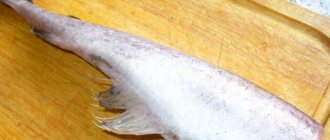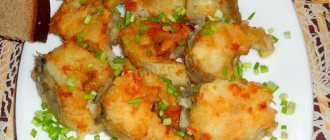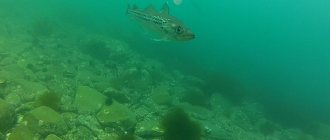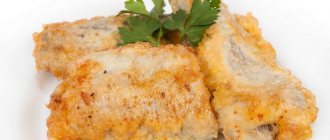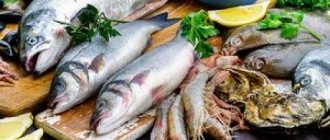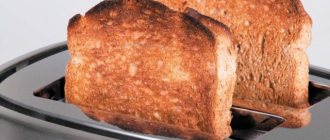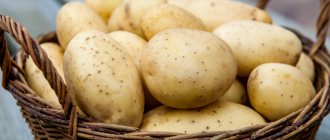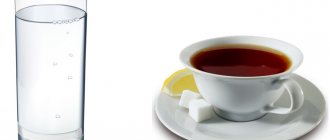Hake is very similar to pollock, but has some differences. These fish have different colors. Hake is characterized by the presence of light gray sides and belly, and a dark gray back. The color of pollock has frequent dark spots.
Another difference is the barbel on the pollock’s chin. Fish also have different numbers of dorsal fins. As for the choice of hake or pollock, it is important to start only from your taste preferences and budget.
What kind of fish is this?
Hake belongs to the Cod family and lives at a depth of more than 1000 meters. More than 12 species are known in the genus Merluza or Heki (lat. Merlucciidae).
Is hake good for a healthy diet?
Hake is an excellent source of protein and, unlike meat, does not contain large amounts of saturated fat. This white fish also contains omega-3 fatty acids, although in smaller quantities than salmon.
What does hake fish taste like?
Although flavor and texture vary depending on the species, hake has a very mild flavor, with slightly sweet meat and creamy (sometimes slightly pinkish) flesh, but a somewhat rough, watery texture.
Is hake a cheap fish?
Hake is a versatile and inexpensive alternative to cod. This fish can be baked and fried, used in soups and stews, made into fish cakes, etc. The hake can also be grilled or fried and served whole. In Spain and Portugal, hake is one of the most popular types of fish and is considered the best representative of the Cod family.
The meat of this sea creature is easily digested by the human digestive system. It is not without reason that hake is used to prepare dietary dishes. Let's take a closer look at the characteristics of the fish, and also figure out how useful hake is for humans and whether it can cause harm?
Pollock and red hake
Part C: Long-term variability: pollock and red hake
As you have seen, short-term climate changes often occur in cycles. In most cases, when climatic conditions returned to "normal", fishing conditions and the number of landings were also restored. But what consequences could accompany a persistent, unidirectional climate change trend? In particular, how might global warming affect fisheries?

The IPCC graph shows the projected changes, impacts and risks to ocean ecosystems from climate change under two emissions scenarios. The scenario on the left, the RCP 2.6 scenario, is based on emissions that peak in mid-century and then decline substantially over time. RCP 8.5 on the right is based on a business as usual carbon scenario. Click to enlarge.
1. Read the WWF fact sheet Climate Change: Oceans and Fisheries (Acrobat (PDF) 2.4MB, August 2010, August 20) to learn about the potential long-term effects of global warming on global fisheries.
Arrival
Answer the following questions to test your understanding of the information contained in the WWF report.
According to the fact sheet, what are some of the major challenges facing the ocean due to climate change?
Rising sea levels due to ocean warming changes in ocean circulation, wind, storms, waves lower salinity lower oxygen levels
ocean acidification
Why are fish more sensitive to temperature changes than many other animals?
Fish are more sensitive because they are cold-blooded and cannot maintain a constant body temperature, but instead usually have the same temperature as the water in which they swim.
How might rising ocean temperatures affect aquaculture?
Aquaculture may suffer as certain areas lose the ability to grow the species they currently grow due to rising sea levels and the location of the sites. Most farmed fish are carnivores and require wild-caught fish to feed them. In developing countries where wild catches are exported for feed, catches will decline and catches will be forced to process fish into food for local people.

From the EPA. This graph shows the annual change in latitude (movement in miles) and depth (feet) of 105 marine species along the northeast coast and eastern Bering Sea from 1983 to 2015.
A recent study examined the potential effects of long-term climate change on global fish populations. They determined that some fish species responded positively to warming, but more species responded significantly negatively to warming. They also found that ocean warming has already reduced catch potential by 4% since 1930 - that's 1.4 million tons of fish over 80 years. One of the study's authors wrote the following article about the findings: Warming oceans are forcing fisheries to move, helping some but hurting more. Your teacher may ask you to read this article.
Next, you're going to take a look at two U.S. fish species already affected by warming to see how their ranges have shifted or are changing, and what the future might look like for them and the fisheries their species support.
Alaskan pollock in the Bering Sea
Walleye or pollock is a species of whitefish related to cod.
2. Watch this short video to learn more about Alaskan pollock.
A fish called pollock
Alaska's largest concentration of pollock is in the eastern Bering Sea by share of the catch and is considered one of the best managed fisheries in the world. Juvenile pollock feed on zooplankton and small fish. Old pollock feed on other fish, including juvenile pollock. Many other species, including Steller's sea lions and other marine mammals, fish and seabirds, feed on pollock and rely on it for survival.
3. Visit the EPA's Marine Species Distribution page, scroll below the graph that appears, and select the option Figure 3, Average Occurrence of Fish in the Bering Sea, 1982–2015 . When it loads, check the Alaska Pollock checkbox to see its map, and drag the date slider to see the change in Alaska Pollock distribution from 1982 to 2014.
Research on pollock in Alaska recently showed that, along with the species' northward migration, warmer temperatures are now leading to an earlier and longer spawning period. Research has also shown that during years of temperature stress, juvenile pollock, unlike adults, may take refuge in cold waters outside the Arctic and switch their consumption habits from regular copepods to plankton, although these contain insufficient nutrition to prepare the juveniles. for the winter or even krill.
4. Study the graphic that shows the estimated range change of pollock through the year 2100. Gray areas indicate areas of the projection grid that are not suitable for thermal habitat. Habitat quality is higher in areas with greater blue intensity. Consider what this means for Alaskan pollock as the ocean warms in the future.
Red hake from the Mid-Atlantic to the Gulf of Maine
5. Watch this short news video about ocean warming in the Gulf of Maine.
Maine Climate: Warming in the Gulf of Maine from News Center Maine
Red hake is a species of small whitefish related to cod that is caught year-round from Maine to North Carolina. Red hake feed mainly on crustaceans such as decapods and stone crabs, as well as fish such as haddock, silver hake, sea robin, sand lance, mackerel and small red hake. The main predators of the red hake are the spiny dogfish, cod, goose and silver hake.
data from NEFMC
The northern red hake stock is not considered to be overfished or overfished. However, in 2021 the southern red hake stock was found to be overfished and managers called for the catch limit to be reduced by 38% to help the population grow.
6. Play these video clips to see the distribution of moving species from 1968 to 2014. The left shows the distribution in the spring for the years indicated, and the right shows the distribution in the fall.
7.Visit Reuter's Ocean Shock interactive graphic and scroll through to read and see how the ocean has warmed over the past fifty years and what that has done to the movement of marine species. When you reach the last page of the figure, in the upper left corner, you can select Red Hake to see its movement both from north to south and from shallow to deeper water.
Arrival
How far has the average hake population moved in the 50 years from 1967 to 2021?
About 59 miles north and deeper.
Stop and think
4: Discuss the challenges facing the southern Georges Coast/Mid-Atlantic fisheries, where red hake are considered overfished and are also moving north due to rising ocean temperatures.
5: Discuss the problems associated with species migration due to climate change. Consider both environmental and fisheries concerns. You can use the IPCC image at the top of the page for reference.
6: Let's look at the different ways climate and oceans are changing. How could fish and fisheries be affected by more than just warming waters?
Additional extensions
.
The nutritional value
Hake can most often be found on sale frozen. In this way, its beneficial qualities, of which there are many, are preserved as much as possible. Contains a large number of micro- and macroelements:
- phosphorus;
- zinc;
- iodine;
- potassium;
- magnesium;
- iron;
- fluorine;
- calcium;
- sodium;
- sulfur;
- chlorine;
- manganese;
- copper;
- nickel;
- cobalt.
Hake fillet and caviar also contain vitamins: A, C, E, B1, B2, B6, B9, B12, PP.
In addition, it contains omega-3 and other unsaturated fatty acids that are important for human health.
The calorie content is low - approximately 86 kcal per 100 g.
Agree, the list of useful components is impressive.
Dory fish.
Chemical composition and calorie content
You can buy hake in most large stores. Most often it is offered frozen. By freezing the fish retains its nutrients.
The composition contains Vitamins A, Vitamins B, C, D, PP, micro- and macroelements, such as: calcium, iron, cobalt, potassium, sulfur, phosphorus, nickel, copper, iodine, zinc, magnesium, fluorine.
Fish contains a lot of proteins and fatty acids.
If you take 100 grams of hake fillet, it will contain 86.002 kcal. At the same time, boiled meat in the same amount contains 84.203 kcal, baked meat – 92.316 kcal, fried – already 105 kcal.
Pollock is a fish available to almost every family, despite the crisis. This fish is rich in phosphorus, iodine, potassium and sulfur. It contains a fairly high percentage of vitamins A, PP and E. A large amount of B vitamins makes pollock useful for the functioning of the brain, nervous system, heart and blood vessels.
The calorie content of pollock is low - about 70 kcal per hundred grams. Pollock can be eaten even during diets. This fish nourishes the body with all the necessary elements and perfectly satisfies the feeling of hunger. Pollock is good for teeth, hair, skin, lungs and after serious illnesses. Pollock is necessary for people who are iodine deficient.
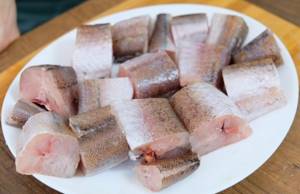
Pollock has a low cost, but is not inferior in usefulness to other types of fish. Pollock also contains a lot of useful substances, and this fish is useful during pregnancy. There are practically no contraindications for eating pollock. The only thing is that salted fish may be contraindicated for diseases of the kidneys and gastrointestinal tract.
Interesting fact: thanks to its unique composition, low energy value and a wide selection of cooking methods, pollock is one of the most favorite fish among those losing weight, as well as those who monitor their weight and their own health. Tender dietary meat, which contains practically no bones, is used to prepare casseroles, cutlets, soups, and broths; in addition, fish is stewed, dried, salted, smoked, baked, etc.
Beneficial features
Having a rich range of useful substances, hake can serve as a real cure for some diseases. Here is a list of the most common diseases in which the consumption of this fish of the cod family has a noticeable positive effect.
Thyroid diseases
Hippocrates stated: “We are what we eat. Food should be not just food, but medicine.”
And this statement is absolutely suitable for people suffering from thyroid diseases.
A healthy, well-thought-out diet has a beneficial effect on the functioning of the thyroid gland, normalizing its activity. And hake fish is one of the healing products that a person with a disordered endocrine system can include in their menu.
The fact is that to restore the functional health of the thyroid gland, it is necessary to regularly consume various seafood rich in iodine, vitamins and amino acids. Hake cooked in a steamer (but not fried) is an ideal dish in this regard.
What are the health benefits of mackerel?
Nervous disorders
Nerve cells are not restored. This saying is known to everyone, but in modern society it is extremely difficult to save them.
For the prevention of diseases of the nervous system, as well as in the process of combating existing disorders, hake caviar will help. Rich in a wide range of vitamins, it can normalize the basic functions of the central nervous system (CNS).
Diabetes
Diabetes is a real disaster for humanity. If you get sick, you must follow a strict diet and monitor your blood sugar levels.
Hake, like no other fish, is suitable for performing two tasks at once. A large number of dietary dishes can be prepared from fillet. In addition, fish fillets and caviar lower blood sugar.
Navaga - beneficial properties.
Which fish is healthier: pollock or hake?
Fish, without a doubt, is not only tasty, but also a healthy part of your weekly meal. It is necessary for the human body to replenish its reserves of proteins, unsaturated fatty acids, vitamins and minerals. Fish is especially useful as a low-calorie dietary product for children and the elderly. Not only delicacies such as sturgeon or salmon are attractive, but also more budget-friendly fish such as hake and pollock.
When purchasing, people often think that hake and pollock are healthier, but to make the right choice, you need to familiarize yourself with the composition and understand the individual characteristics of each species.
Cod fish, what is it?
Cod and pollock belong to the cod of marine inhabitants of the oceans. They, as a seafood product, are in demand not only by residents of coastal areas, but throughout the country. They are attractive:
- Its dietary, tasty, tender meat is rich in proteins, vitamins, and minerals, especially phosphorus and calcium.
- Recommended for inclusion in the diet of children and pregnant women , as well as during lactation.
- They are sources of iodine , which is necessary but scarce in many areas.
- Both types are low-cost fish products and are popular among the population.
The appearance and color of the scales of hake and pollock are noticeably different from each other:
- The hake has approximately the same thing: the back is grayish-black , and the belly and sides are light gray.
- Pollock has many frequent black spots light gray surface
- Externally, the body of the hake is elongated evenly along its entire length.
- Pollock is wider at the head and gradually tapers towards the tail.
- A barely noticeable barbel on the chin of pollock, a distinctive feature from hake.
- The hake has a short dorsal fin, which is located closer to the head, and another longer one with a notch.
- Pollock has three fins clearly visible on its back.
Hake and pollock included not only diversify the diet, but also strengthen the thyroid gland , a regulator of human health.
The benefits of pollock
Pollock, from the cod family, is caught mainly in the cold waters of the Pacific Ocean and, in terms of production volumes, ranks first in comparison with other cod fish, including hake. In the area of the Kuril ridge, Sakhalin Island, and the Far East, pollock is considered not only tasty, but light and healthy food . Due to its availability, every family loves this fish and knows how to cook it properly.
The nutritional value
Pollock fish is rich not only in nutritional composition, but also in a large number of microelements and vitamins . It contains quite a lot of proteins, fats and almost no carbohydrates.
- There is little fat, only 0.9 g per 100 g of product, which makes fish useful in diets.
- There is quite a lot of protein of animal origin, about 15.9 g per 100 g , which is 500 g, which is the daily requirement for an adult.
- Among the vitamins there are “A”, “E”, group “B” , especially “B12” .
- Vitamin PP , nicotinic acid, involved in the formation of enzymes in living cells.
- There are a large number of macroelements in pollock, providing up to 30% phosphorus, potassium and magnesium in 100 g of pulp. And also 100% iodine, 150% cobalt and 110% chromium.
- Omega-3 unsaturated fatty acids provide about 20% of the norm.
- Pollock is famous for its low calorie content of 70 kcal per 100 g .
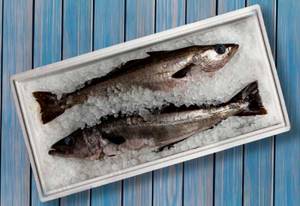
The benefits of pollock for the body
Pollock has great nutritional value:
- It is recommended to be used in all therapeutic and health diets; it satisfies the body with its rich chemical composition and does not cause a feeling of hunger .
- The composition of micro and macroelements is beneficial for tooth enamel, ensures hair growth, and improves skin condition.
- Pollock is recommended to be included in the diet for many diseases , such as endocrine system failure, diabetes, diseases of the cardiovascular system , and housing and communal services diseases.
- For people who lack iodine , it is recommended to eat it regularly.
- For those who are obese , pollock is useful as a low-calorie product.
The benefits of hake
Deep-sea hake is caught in the waters of the Pacific and Atlantic Oceans in many countries around the world and in Russia. The caught fish is processed immediately at the fishing base so that it does not lose its aroma and taste properties . This ensures that all the beneficial nutritional properties of hake are preserved.
The nutritional value
Hake, like an oceanic cod fish, is quite large in size, up to 70 cm and weighing up to 3 kg . Rich in all mini and macro minerals and vitamins important for the human body. The useful components include:
- In the ratio per 100 g of hake pulp contains: proteins about 16.6 or 11%, fats about 2.2 g or 5%, carbohydrates 0%, dietary fiber 0%.
- Calorie content per 100 g of pulp is only 86 kcal .
- 100 g of hake pulp contains micro- and macroelements: Magnesium (9%), Sodium (3%), Potassium (10%), Iron (4%), Phosphorus (24%), Zinc (6%).
- One 100 g serving of hake contains B vitamins: B6 (5%). B12 (40%), also D (8%), PP (7%), A (4%) and E (8%).
- The composition includes beneficial monounsaturated fatty acids , which are not produced by the body itself.

The benefits of hake for the body
When frozen, hake retains its beneficial properties as much as possible, such as:
- Hake, as a gentle, soft product, normalizes digestion and neutralizes and removes carcinogenic components in the body.
- The antioxidants contained in fish pulp have a great therapeutic effect on the heart and blood vessels
- It is useful to eat hake, which contains Omega 3, iodine, to regulate the functioning of the thyroid gland, as well as to improve the condition of the skin and hair growth.
- It has a noticeable positive effect on depression and nervous disorders, strengthens the immune system .
- If you have diabetes, hake dishes will help you follow a strict diet . It has been observed that fish lowers blood sugar.
Contraindications and recommendations
Sea fish pollock and hake which are similar in composition , are very healthy and are recommended for almost anyone to eat in a variety of dishes, as an independent product or as a component in other recipes.
In some cases, they may be contraindicated for use according to the following recommendations:
- Individual intolerance to fish products in general or pollock and hake separately. They are not recommended for those with seafood allergies.
- Seafood products from pollock and hake may contain excessive amounts of salt , which is not recommended for people with high blood pressure or irritation of the mucous membranes of the stomach.
- All marine fish are often infected with parasites. If their presence is detected or suspected, it is better to stop using them.
- Sea fish cannot be eaten raw, only after heat treatment.
- People suffering from constipation are not recommended to eat these types of fish in large quantities due to the presence of iron in them, which acts as a binder for digested food.
- For those who experience increased acidity in the body , it is recommended to eat fish food in small quantities so as not to cause irritation in the stomach.
- Pollock and hake fish are not very bony , but they are chosen with the greatest care for children.
Improper storage of fish can cause poisoning with serious consequences .
Conclusion
The choice between pollock and hake, which of them is more useful, is definitely difficult and useless. Both types are almost equally healthy and contain great nutritional value , almost equal in calorie content. Contraindications and recommendations apply to both hake and pollock.
They differ in size, weight and appearance, and most importantly, in cost, by about one and a half times. The price difference is explained by the fact that hake is more difficult to preserve, while pollock is caught in larger quantities, making it more affordable.
The choice depends on the personal preferences of the consumer and his finances.
Related materials:
Harm and contraindications
Despite all the positive properties, hake has a number of contraindications. Ignoring them can cause serious health problems. Therefore, we will consider in as much detail as possible the harmful qualities of hake.
- Allergic reaction. Like any seafood, hake fillet and caviar can cause serious allergies if there is an individual intolerance to the components. Therefore, it is better for allergy sufferers to refrain from eating this fish for medicinal and preventive purposes.
- Constipation. Fish fillet contains a lot of iron, which has a binding effect and is contraindicated in large quantities for constipation.
- Increased acidity of the body. In this case, eating hake is strictly prohibited. Fish meat and roe can further increase the acidity level and cause aggravation.
Despite the fact that it is quite easy to remove the bones from hake fillets, refrain from feeding this fish to small children. A large number of small bones increases the risk of a child choking or getting a bone stuck in the throat. In addition to the obvious danger to the respiratory system, this can cause severe fear and other unpleasant consequences for the baby.
Heavy metals
Seawater contains heavy metals such as mercury and various fatty pollutants. They are absorbed by algae, which in turn are used as fish food. As a result, harmful components penetrate the body of commercial fish, and subsequently onto the human table.
There is a list of species that are most capable of absorbing heavy metals. These primarily include cod, including hake.
Heavy metals have a negative effect on the human body, especially if it is weakened for any reason. The risk zone includes children, pregnant and lactating women, as well as the elderly. For these groups of people, the presence of hake in the diet should not be made regular.
Effect of polyphosphates
When freezing and packaging fish, manufacturers use food additives/stabilizers - polyphosphates (designated as E452). They are needed to retain moisture, maintain shape without deformation during defrosting and extend the shelf life of the product.
Despite the fact that some food additives are officially approved by the Ministry of Health, they negatively affect the human body, contaminating it with chemicals.
Parasite infestation
Any fish can contain parasites (adults and larvae). Before eating, it is necessary to carry out thorough heat treatment.
Otherwise, there remains a risk of infection - anisakiasis. Symptoms: nausea, vomiting, rumbling in the stomach, flatulence, suffocating cough, extensive urticaria. If one or more of these symptoms occur, seek medical attention immediately.
Hake or pollock - what to choose?
Pollock is often compared to hake, considering them interchangeable products. Moreover, some buyers do not particularly understand the difference between these fish. But there are differences, and quite significant ones.
- Nutrients. If we compare the benefits of pollock and hake, then the second contender wins (in terms of the total amount of vitamins, proteins and microelements).
- Price policy. Pollock is the most budget-friendly fish product than hake.
- Taste qualities. Many gourmets believe that hake fillet is more tender and juicy. However, pollock liver is valued as an exquisite delicacy containing a large amount of vitamin A. And here the favorite is obvious.
